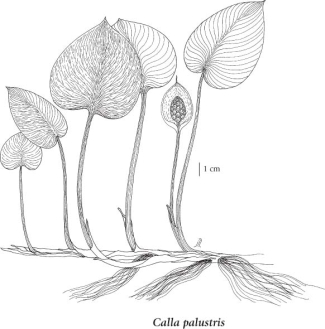Calla palustris L.
wild calla (water arum)
Araceae (Arum family)
Introduction to Vascular Plants
wild calla (water arum)
Araceae (Arum family)
Introduction to Vascular Plants
Species Information
General:
Perennial aquatic herb from a long, creeping rhizome; stems solitary, 10-20 cm tall.
Leaves:
All basal, blades egg-shaped to broadly heart-shaped, entire, 5-12 cm long, 4-11 cm wide, long-stalked.
Flowers:
Inflorescence of numerous, densely packed, perfect (or sometimes the upper male) flowers in a cylindric to ellipsoid spike 1-3 cm long, the spike subtended by a bract (spathe) similar to the leaves in shape but white and slightly smaller; perianth absent; ovaries 1-celled.
Fruits:
Berry-like, egg-shaped, red, 5 mm long; seeds 6 to 8.
Illustration

If more than one illustration is available for a species (e.g., separate illustrations were provided for two subspecies) then links to the separate images will be provided below. Note that individual subspecies or varietal illustrations are not always available.
Illustration Source: The Illustrated Flora of British Columbia
Ecology
Ecological Framework for Calla palustris
The table below shows the species-specific information calculated from
original data (BEC database) provided by the BC Ministry of Forests and Range.
(Updated August, 2013)
The table below shows the species-specific information calculated from
original data (BEC database) provided by the BC Ministry of Forests and Range.
(Updated August, 2013)
| Site Information |
Value / Class |
||
|
Avg |
Min |
Max |
|
| Elevation
(metres) |
842 | 420 | 1237 |
| Slope
Gradient (%) |
0 | 0 | 1 |
|
Aspect (degrees) |
141 | 142 | 142 |
| Soil
Moisture Regime (SMR) [0 - very xeric; 4 - mesic; 8 - hydric] |
7 | 7 | 8 |
| Modal
Nutrient Regime
Class |
D | ||
| #
of field plots species was recorded in: |
19 | ||
| Modal
BEC Zone Class |
SBS | ||
|
All BEC Zones (# of stations/zone) species was recorded in |
BWBS(2), ICH(3), IDF(1), SBPS(4), SBS(9) | ||
|
Source:
Klinkenberg 2013
|
|||